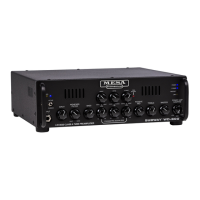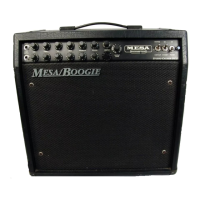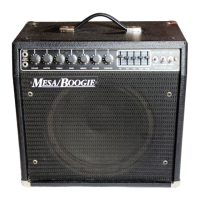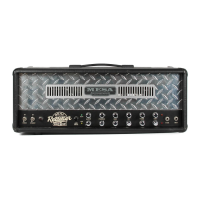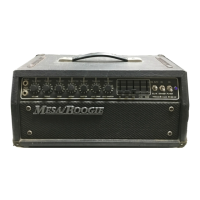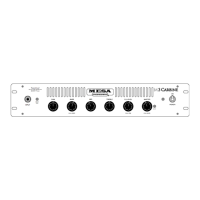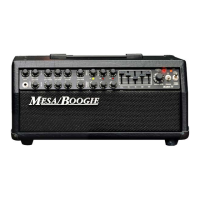combined with the BASS CONTROL adds another dimension of tone sculpting by rolling off the extreme low end when boosting the
bass eq control, allowing for some unique low mid voicings. Use enough to get the job done and no more. Note that if you have very
compact cabinets and need high volumes, you will want to be aware that it is possible to overdrive speakers with excessive bass
boost. If your speaker is not getting you enough high level low end, it’s possible that you do not have enough “rig for the gig”, and
“more speaker” is needed (or there is possibly damage to the speakers).
TREBLE CONTROL:
This active eq control is a shelving filter that is responsible for the amount (or volume) of high frequencies
present in the signal, relative to the rest of the spectrum. High frequencies (>2.5kHz) are responsible for the “bright”, “airy”, “clarity”,
“shimmery” character of the tone. This is an active control with boost and cut, the amount of boost proportional to the clockwise rota-
tion to the right of “flat” (12:00 straight up) position and the amount of cut proportional to the counter-clockwise rotation to the left of
“flat” (12:00 straight up) position.
PARAMETRIC MID EQ CONTROLS:
MID CONTROL:
This control is a peak-dip (or bell) style filter that is responsible for the level (or volume) of the correspond-
ing midrange frequencies present in the signal, relative to the rest of the spectrum. The center frequency of the mid band being
affected is selected with the mid frequency control (the next control to the right). This is an active control with boost and cut, where
the amount of boost is proportional to the clockwise rotation to the right of “flat” (12:00 straight up) position, and where the amount of
cut is proportional to the counter-clockwise rotation to the left of “flat” (12:00 straight up) position of. Remember that a little eq goes
a long way, use just enough to get the job done.
MID FREQ CONTROL:
This control is responsible for selecting the center frequency (or pitch) that the MID EQ control acts
on. Rotating this control sweeps the center frequency from lower (counterclockwise) to higher (clockwise). If the eq gain control is set
at 12:00 noon (“flat”), there will be no effect when rotating the frequency control because there is no boost or cut being performed.
Sweep range is 150Hz – 2.5kHz. The frequency distribution of the sweep control is linear from endpoint to endpoint. It should be
noted that these controls do not act on a single frequency but act on a range of frequencies approximately 1/3 of an octave on each
side of the center frequency.
CHANNEL “MASTER” VOLUME CONTROL:
This control is responsible for the level of the SUBWAY CHANNEL being
sent to the power amp, and determines the playing volume of the SUBWAY CHANNEL relative to the BOOGIE CHANNEL. Using the
CHANNEL MASTER VOLUME along with the INPUT GAIN control allows the optimal control over playing volume. For example, if
you are using high input gain to achieve an overdriven tone, it will be likely be necessary to adjust the CHANNEL MASTER VOLUME
down to obtain a reasonable playing volume. Likewise, if you are looking for a very clean tone, you may wish to start with a lower
INPUT GAIN control setting and use a higher CHANNEL MASTER VOLUME control setting to obtain the desired playing volume.
The CHANNEL MASTER VOLUME control operates in a linear fashion, an increase in volume continues linearly throughout the
entire rotation of the control.
MASTER SECTION:
CHANNEL SWITCHING:
This is a true 2 channel amp with A/B switching available either on-board via this mini-toggle switch
or via an optional footswitch. This allows for switching between the SUBWAY and BOOGIE CHANNELS, and since the switching is
done after each channel’s EFFECTS RETURN jack, there is the additional feature of being able to substitute your “favorite” preamp
in place of one of the on-board preamps by plugging the out-board preamp into the effects return in place of one of the on-board
preamps and having the amp switch between it and the remaining on-board preamp. As an extreme example, this amp could also be
used with 2 outboard preamps, as a switching platform with a power amp. When using it this way, the POST-EQ DIRECT OUTPUT
will still provide the switched signal post-channel volume control. When used with the optional footswitch (available from our dealers or
our on-line store), this mini-toggle switch must be in the down position otherwise the BOOGIE CHANNEL will over-ride the footswitch.
OUTPUT OVERDRIVE SYMMETRY:
Another “new” concept introduced in the SUBWAY TT-800 is the OUTPUT OVER-
DRIVE SYMMETRY control, which provides adjustment to the symmetry of the output soft clip circuitry waveform just like how many
tube phase inverters and tube output stages behave in real world tube amps. This works in conjunction with the internal damping
PAGE 7
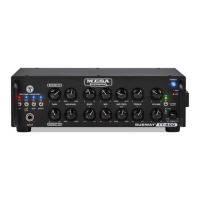
